An Ode to the Desert Jackass
Winter 2021
Move over, dog; man had a different best friend in the 19th century.
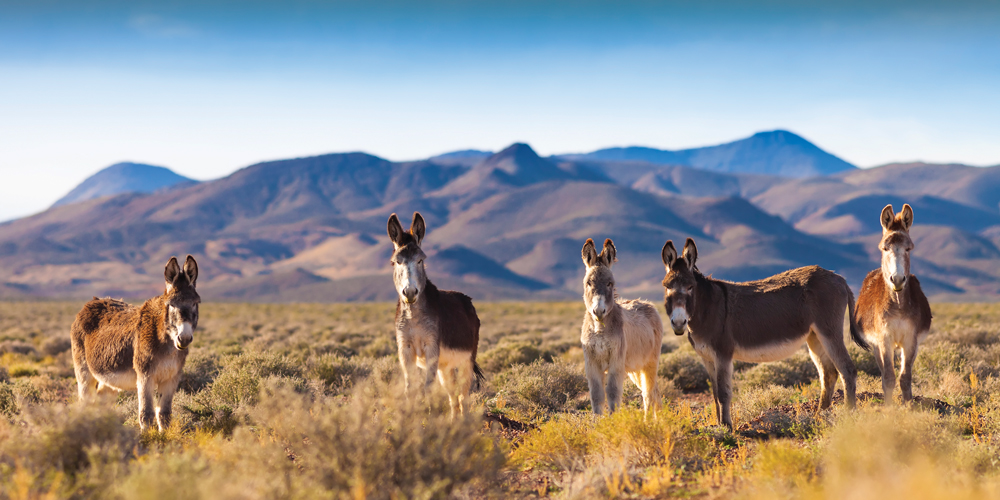
BY ERIC CACHINERO
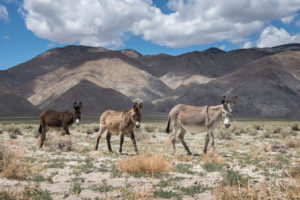
Reno and Sparks; the sage and the pine; picons and more picons—Nevada has indeed churned out the most inseparable of dynamic duos. Both in legend and reality, however, indisputably no more inseparable pair exists than the desert silver miner of the 19th century and his oft-plodding desert jackass. Yea, the dopey donkey may have at times been scrutinized by nonbelievers for its seemingly inferior mental aptitudes, but next to the pickaxe and pan, this venerable beast was one of the most sharpened and indispensable tools in the miner’s repertoire. Across the high and low ore fields of Nevada’s frontier, the unmistakable harsh hee-haw bray of these desert dwellers must have been music to the pioneer’s ears, for whether it was silver or water he sought, the mining man’s best friend blazed trails at a near-snail’s pace, though they always led to riches.
A “HORSE” WITH MANY NAMES
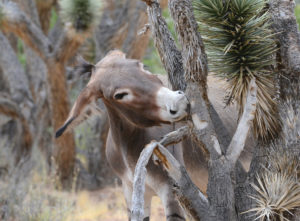
Doctorate degrees have been procured that required less terminology than learning the dynamic naming of the desert jackass. The 1,000-times great grandfather of the common iteration of the donkey—the African wild ass (E. africanus)—roamed the plains of Africa, and still do today, though only 570 members of the critically endangered species exist. The modern descendants can be found in much greater numbers (some 40 million in the world). As an overarching term, both male and females are referred to as donkey, burro, or simply ass. Males are called jackass or jack, while females can be called jenny or jennet. When donkeys are crossed with a horse, the terminology becomes even more entangled. A mule is an infertile cross between a male donkey and a female horse, while a hinny is the same crossbreed with opposite parental genders.
These million-moniker marvels—for some strange reason—have been fascinating mankind since the time of the ancient Egyptians, and were eventually brought to Mexico by the Spanish in 1528. History maintains that the donkey was first brought across the Rio Grande in 1598 by Spanish Conquistadors, and eventually made their way into the area that would become southern Nevada, where they would prove themselves as a relentless load-bearing workhorse, and a prosperous prospector.
DESERT ANGELS
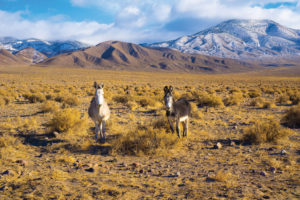
It is almost as if the desert jackass was born and bred to survive in Nevada. There have been countless stories in western lore of a lowly prospector dying of dehydration putting his blind faith in his trusty steed, who sniffs out and leads the way to a hidden desert spring. The inferior human (H. sapiens) will require immediate medical attention if it loses 10 percent of its weight in water dehydration. The vigorous burro, on the other hand, can lose up to 30 percent, and rehydrate in a mere five minutes (it takes humans a day). The only animal in the world that is comparable is a camel. So why didn’t the prospectors simply use camels? Maybe it was their highly inferior sense of smell.
In the Spring 1967 issue of Nevada Magazine, author Anthony Amaral pondered:
“The straying burro, capricious and even clairvoyant according to some prospectors, was highly cussed by burro-men who had to search far and wide when their burros took leave of camp. Still any old mining manual advised that the burro was best for desert prospecting.
But prospectors didn’t read mining manuals. These were considered just a lot of foofaraw. If you were to ask why they chose the burro instead of a mule or horse, one answer might be that the burro ‘smells the ore in rock.’”
The desert jackass—much like its modern political counterparts—is also world-renowned for its stubbornness. This stubbornness, coupled with the animal’s tendency to wander off, has led to some of the most famous fables in Nevada history.
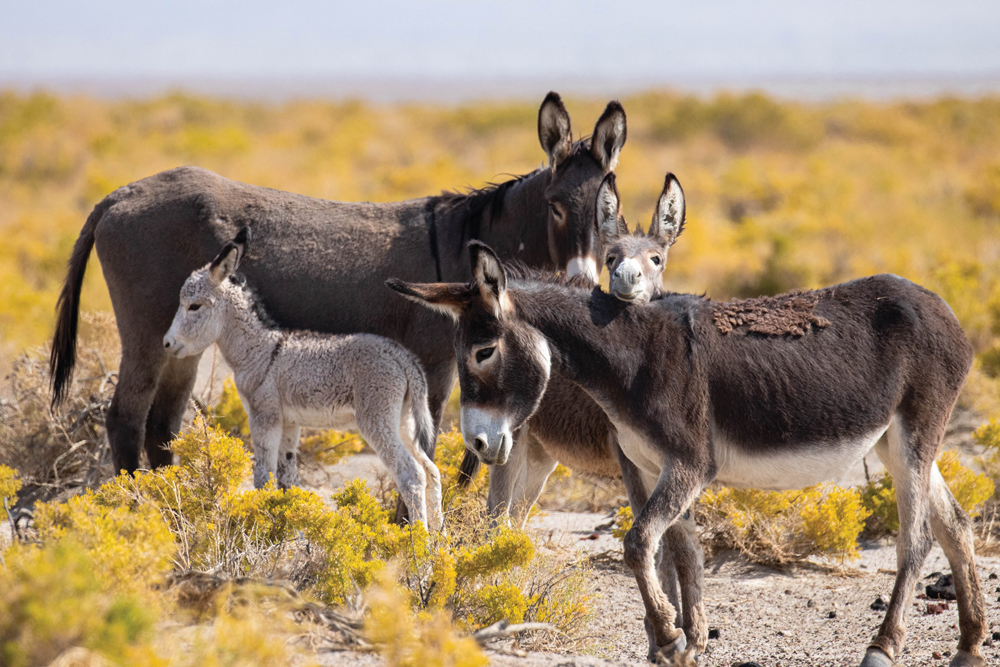
ME AND Jim
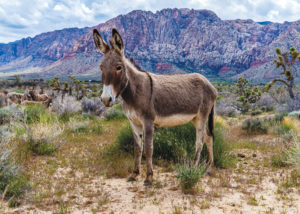
Even before they first learn of Santa Claus, many native Nevadan boys and girls are told the legend of Jim Butler and his mulish—yet serendipitous—burro. The story maintains that in 1900, while pursuing a stubborn wandering donkey in the Manhattan range in central Nevada, rancher and hobby prospector Jim Butler bent down to pick up a seemingly unremarkable rock to throw at the animal to get its attention. The rock that Butler picked from the ground just happened to be high-grade silver ore, kicking off one of the largest mining booms in the state’s history, and creating the town of Tonopah.
Though this legend is well-known, outrage exists just beneath the surface of the wealthy and high-brow Mr. Butler’s story. Butler’s name rings throughout the history books; monuments, celebrations, plaques, bars, hotels all bear his name. But what about Butler’s desert jackass—the sole creature that bears the weight of the very history of this great state?
Surely let us forget not that without his jackass, Butler’s name would have faded from these pages entirely. Editor William McClure Gottwaldt of the “Progressive West” newspaper knew this, and in 1906, he penned a commentary that paid respects to both man and mule. Gottwaldt argued that a stone monument of Butler should find itself erected on the streets of Tonopah, yet in great fear that it should slight the faithful jackass, he included the following ode to be inscribed and immortalized into the stone:
I’m the burro. Don’t forget me
When you hew Jim out of stone.
I will tell you, if you let me,
How this Midas ledge got known;
To slight me cuts my feelings raw,
For Me and Jim found Tonopah
Dates and data we’ll dispense with
and all geologic rot,
But the narrative commences with Me
ME standing on the spot,
A-sizing up the ledge I saw
Where ME and Jim found Tonopah
Manganese or brittle silver?
Didn’t know and didn’t care,
But I noticed on that hill, sir,
Clumps of brunch grass growing where
The world will countless treasured raw.
Thus ME and Jim found Tonopah
So, when you erect Jim’s statue,
Don’t omit your long eared friend,
And I’ll emphasize it that you
Won’t regret it in the end,
So gratefully I’ll Haw! he! Haw!
FOLLOW YOUR HEART
As fabled as the desert jackass may be, today we may take solace in the fact that these four-legged miracles are real and still exist en masse in many areas of Nevada. So, if it’s riches you seek, or find yourself with cracking lips and a parched tongue, you may consider following the soothing song of the magical hee-haw brays deep into the calm winter nights and well into the hot summer days. See where they lead you. It’s cheaper than a lottery ticket and will probably be more fruitful.

